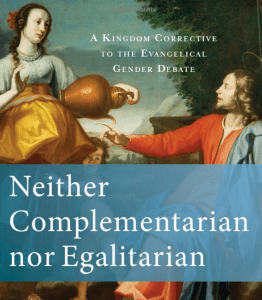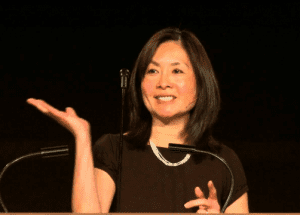Recently, Kevin DeYoung, a pastor, author and leader in The Gospel Coalition, posted at TGC’s site on the 9 marks of healthy biblical complementarianism, and today I will respond to his points in italics — left in their original context and you can go to the link to see the original post and the comments there. I found his post in tone entirely acceptable but theologically inadequate. You can read his piece consecutively below by ignoring my italicized responses.
In the conservative evangelical circles I mainly inhabit, there is almost no controversy about whether the Bible allows for women to be ordained as pastors and elders. The people I talk to and listen to are firmly convinced complementarians. That is, they (we) believe that God created men and women equal in worth and dignity but with different roles in the home and in the church. At least very least, this means the office of pastor or elder is to be filled by qualified men. The core of complementarianism is not up for discussion.
DeYoung’s circles could be improved with some expansion to interact with those with other thoughts and points of view. In his understanding of complementarianism it is unjust to represent complementarianism in terms of only worth and roles, for those roles are shaped by hierarchy in those same circles. It is not hard to argue that hierarchy determines roles. Complementarianism, as understood by complementarians, entails patriarchy and hierarchy, not just worth and roles.
To say the “office” is to be “filled” by “qualified men” is to extrapolate from but not state what is in the Bible. The Bible never ever — not once — says only males can be pastors and never says only males can be elders (bishops, too, I assume). The elder list assumes they are males; that is not the same as teaching it. It also assumes deacons are males but Phoebe, a woman, is a deacon. Reverse the logic and one could say women could be elders/bishops.
How we talk about complementarianism is.
Agreed.
And how we practice complementarianism too.
I agree even more so.
Is the problem that we lack courage or that we are missing compassion? Have we gotten too soft? Or have we gotten too restrictive? Does complementarianism need a re-branding, a reformation, a revival, or a retrieval?
The conversations can be pointed, the rhetoric heated. And yet, the fact that there is an intra-complementarian discussion taking place is a sign of the relative success of the movement. The complementarian camp is large enough to contain a fairly disparate group of people and personalities. The presence of disagreements and the need for definitions should come as no surprise. Sharpening is not a problem, so long as we are not unnecessarily sharp with each other.
Let’s hear a description of these debates.
So what does a health[y] complementarianism look like? I certainly don’t have the last work on the subject. But here are nine important marks.
1. Creation not accommodation. The differences between men and women are rooted in divine design. This is clear from 1 Timothy 2 and from Genesis 1-2. Complementarianism is not about Paul accommodating to a patriarchal first century culture, let alone about us accommodating the expectations of our cultures inside or outside the church. God has something to say about manhood and womanhood. And what God has to say is rooted in what he designed.
Evidently it is “clear” to him and others that Gen 1-2, where not one word is said along this line and themes of even equality are affirmed, teaches a “difference” that pertains to roles in leadership, and there is absolutely no consensus on 1 Tim 2 in spite of what he says. It is not fair to the many fronts of the discussion to say “clear” about anything in 1 Tim 2.
Noticeably absent here is the most significant text in the Bible about manhood and womanhood — the Song of Solomon.
2. Function not simply ordination. The first point may seem obvious, like Complementarianism 101, but it’s an important foundation for this second point. If men and women are different by creational design, then we can’t simply quarantine “ordination” and say that manhood and womanhood have no bearing on church ministry or church roles so long as the pastors and elders are men. The issue is not mainly titles or labels or the laying on of hands. The issue is about function. To be sure, complementarians may not agree on where to draw all the lines concerning home groups and Sunday school classes and public worship, but as a starting place for these discussions we have to remember we are talking about the flourishing of divine design, not adhering to a set of narrow and seemingly arbitrary rules.
DeYoung’s point is that we cannot get to ordination until we know the function of men and the function of women. He contends those functions are shaped by divine design and seen in Gen 1-2 and in 1 Tim 2. This seems reasonable to me, but one has to establish these functions on the basis of exegesis, not assertion. What “function” does he have in mind? It seems it means men lead and women don’t. That’s not in Gen 1-2.
Ordination is not taught anywhere in the Bible, at least as I understand ordination. What he must mean is that women are not called by God into teaching ministries — which flatly disagrees with the Bible. Priscilla and Junia and Huldah. Or he means they cannot lead — which flatly contradicts what the Bible says. Deborah is all that needs to be said. DeYoung fails here to embrace the sufficient examples of women in the Bible who speak God’s word to the nation as prophets and to women like Deborah and Huldah, Priscilla and Junia. He reads Gen 1-2 and 1 Tim 2 in a way, then, that seems to deny other parts of the Bible.
3. Warmly embraced not quickly checked off. There’s a difference between affirming complementarianism as an act of intellectual throat clearing—“Look, I don’t think women should be pastors either, but…”—and joyfully affirming the vision as good and beautiful and best.
Yes there is. This needs to be done far more than it is. Where was this warmth with Mahaney and Ruth Tucker?
4. Convictional not merely traditional. There’s also a difference between a thoughtful complementarianism based on the exegesis and application of Scripture and a clumsy complementarianism that is little more than the default position of an overly prescriptive cultural traditionalism.
Examples. Of course this true. Straw man. Who thinks it is the “default position of an overly prescriptive cultural traditionalism”?
5. Tender not triumphalistic. No doubt, sometimes the troops need to be rallied. In the sexual insanity of our day, the call to courage is surely appropriate. But we need to realize that all kinds of people can be listening in as we talk about biblical manhood and womanhood. Some of those listening are wavering and some are wolves, but some are hurt and some resonate with broken hearts more than with raised banners. We need to be on guard against rhetoric that is all caps all the time. Let us be persuaders, not just pugilists.
More of this, more of this.
6. Principial not personal. It’s human nature: we personalize when we listen and universalize when we speak. Because we’ve gone toe to toe with liberals, we think battle mode is the way to go, always. Or because we’ve had a bad pastor or a brutish boyfriend, we are always slamming the complementarianism we say we believe in. Don’t size up the whole complementarian universe based on a couple of your most painful experiences.
Yes it is principial, and the principials are taught in the Bible, and we disagree at the deepest level here. Genesis 1-2, where is Song of Solomon, where is sacrificial love for the other in Eph 5, where is mutual submission/service?
Yet, the personal is never divorce-able from the principial. When they are it becomes ideology. God revealed himself in his Son, who is very personal and not just principial.
7. Bible and theology affirming not wife and motherhood belittling. We want the women in our churches to read the Bible, study the Bible, and help others understand the Bible. I love that the women at URC are eager to go deep, get good theology, and challenge their hearts and minds. Yes and Amen to women who study the Scriptures. Go ahead and talk about Deuteronomy as well as diapers. And yet, let’s not ridicule the women for talking about diapers! For most women, at some point in their lives, and often for most of their lives, their identity (after being a child of God created in God’s image) will be bound up in being a wife and especially a mother. Moving deeper into the word does not mean moving away from Titus 2.
Again, why these passages and not others?
And let’s not stereotype women into “diapers.” The fathers I know all changed diapers. I spoke this weekend in Austin TX with a woman who has three PhDs — Deuteronomy, diapors, and doctorates. Speaking of the use of “diapers” here… he goes on to urge complementarians to do otherwise:
8. Careful with words not careless. We all use labels. It’s hard to speak of our immeasurably complicated world without them. But if we use negative sounding isms, let’s explain what we mean by them. Let’s not casually label others as “feminist,” “liberal,” “patriarchal,” or “hierarchical,” unless the situation clearly calls for it and we make clear what we mean. A church that has women read the sermon text (a practice I’m not in favor of) is not automatically wed to the spirit of the age, nor is a church which only allows men to teach classes and lead small groups necessarily oppressive and Neanderthal.
Yes. I agree on terms. But these terms are not simply labels; these are often accurate descriptors and DeYoung uses one thoughtfully the whole time through: complementarian. Implying that those on the other side are not complementarian.
One more: “A church that has women read the sermon text (a practice I’m not in favor of) ..” This must refer to the public reading of Scripture, and he says he’s not in favor of women reading the Bible in public — and surely he means in Sunday morning worship services. In the Bible women could not just read the Bible they could be prophets — which means they uttered the very word of God in its first occasion; I have a hard time thinking a woman should not read Mary’s song.
9. Leaning against the culture instead of into the culture. The core convictions of complementarianism will not magically seep into our children or into our churches. The cultural breeze is blowing too stiffly against us. Biblical manhood and womanhood must be taught as well as caught. When it comes to the goodness of God’s divine design for men and women, unless we are pushing forward against the forces of sports and media and politics and business and entertainment, we will end up drifting in wrong direction.
I find this to be a case of what the classical rhetoricians call “insinuatio” — insinuating that those of the mutualist or egalitarian are leaning “into” culture when fantastic arguments have shown that complementarianism is 1950s white suburban American ideology.
I remember years ago hearing a pastor describe his position on homosexuality as theologically conservative and socially progressive. I could tell by the way he was speaking that everything in him was leaning with the wind. He was holding on to orthodoxy by a thin string. So I wasn’t surprised a few years later when he announced the he had changed his mind on homosexuality and now saw nothing wrong with same-sex sexual relationships. In the same way, we must be careful that our complementarianism is deep, thoughtful, rooted, biblical, and utterly at home with being despised, misunderstood, and counter-cultural. Faithfulness does not mean making as many enemies as possible, but it does mean that for the sake of the good, the true, and the beautiful, we are fine with facing opposition when it is impossible to avoid.
Now some more questions:
How can he talk about the relationship of men and women and completely ignore Song of Solomon? Why do complementarians do this so often?
How can he talk about men and women, from the family into church, and not talk about the most important word in the entire discussion: love?
Why is there in this such a concentration on authority lines and roles? Is that not the language game of complementarians? Where is the “blessed alliance” language of Carolyn and Frank James? Womanhood is about ezer-hood, the strong warrior-hood of the woman with the man who go to war against evil with one another.
Why is there nothing here about the Spirit of God and gifts and God’s enablement and — yes — grace, for that is what God does and God gives: grace prompts “gifts” (charis prompts charismata)? Church service teaching and church leading come from God’s Spirit enabling people. Not a word.
Now my biggest problem with the entire piece: Isn’t Jesus the Lord of the church, the crucified Lord the head of the church? Why is there no christological focus in this piece?
So, no christology, no pneumatology and a whole lot of manhood. Sounds like this piece has not only leaned into culture, it has lost his way in culture. The culture of the 1950s, suburban, white.
And no eschatology: where is the kingdom of God here? the incursion of God’s reign in Christ, anticipating in the now the kingdom of God, anticipating the visions of Rev 21-22 and Gal 3:28 and Col 3:11?




















